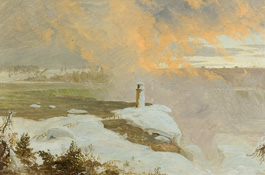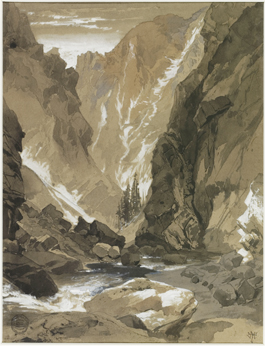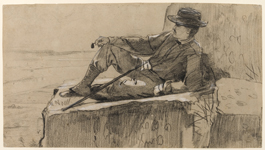home | metro silicon valley index | the arts | visual arts | review

Cooper-Hewitt, National Design Museum, Smithsonian
FALLING: Frederic Church's painting 'Niagara From Goat Island, Winter' shows the falls shrouded in snow.
Wish You Were Here
A new show at Cantor Arts Center traces the 19th-century growth of tourism from art to gift-shop artifact
By Michael S. Gant
IS THIS what the escalating price of gas hath wrought? A lead article in the travel section of the San Francisco Chronicle touted Second Life as a virtual destination. OPEC and Hugo Chavez notwithstanding, America's insatiable lust to be on the move, for at least two weeks a year, can be traced to the 19th century, when alluring images of our natural wonders were commercialized as inducements for troops of tourists.
The selling of America's landscape marvels in the 1800s is illustrated in a fascinating show (traveling, of course, from the Cooper-Hewitt Museum in New York) at Stanford's Cantor Arts Center. The exhibit tracks the process by which artists "discovered" magnificent remote places and their paintings lured intrepid trekkers at first, and later, legions of day trippers taking advantage of cheap fares promoted by the railroads.

Cooper-Hewitt, National Design Museum, Smithsonian
MOUNTAINS MAJESTIC: Thomas Moran's 'Toltec Gorge, Colorado,' is an ink-wash rendering from 1881.
The touristic urge got its start with the spectacle of Niagara Falls. Depictions of the falls were already popular in the form of engravings and painted pottery, including a blue transfer-ware platter from the 1830s, before Ferdinand Reichardt painted a vista that included large numbers of spectators—and even an early photographer under an awning—admiring the raging waters.
The great landscape painter Frederic E. Church arrived in the 1850s, producing views of the falls that erased the inconvenient onlookers and created an iconic image of nature's sublime power at full force. His famous megapainting of 1857, Niagara, is represented by a wall-size reproduction on cloth, but the show does include some wonderful smaller works, most notably an oil on paperboard called Niagara From Goat Island, Winter; the snowy banks of the falls and the darkling waters play underneath orangey spume rising to a low sky full of scudding clouds.
From the White Mountains in New Hampshire to the Adirondacks and Catskills to the rocky West, big-name artists like Church, Thomas Moran and Winslow Homer were followed by guidebook authors, photographers, railroad ad agencies and, finally, gift-shop trinketeers.
Church, who can be a bit overwhelming in his epic mode, could also create big effects on a small scale. Especially riveting is his Sun Rising Over Bar Harbor (circa 1860), a nocturne with low dark hills dominated by a high, intensely bright full moon. Church also could not resist the spectacle of a setting sun igniting evening cloud banks, and several paintings here show his deft touch with dramatic red highlights over silhouetted mountains and shorelines.

Cooper-Hewitt, National Design Museum, Smithsonian
REST STOP: Winslow Homer's 'Study for Mountain Climber Resting,' a black-and-white crayon drawing on paper from 1868–69
Moran was one of the early chroniclers of the national parks to be: Yellowstone, Yosemite and the Grand Canyon. In the show, his subtle, ink-wash sketches of familiar Yosemite landscapes are complemented by some albumen prints by Carleton Watkins, whose sepia tones echo Moran's brush strokes. Such was Moran's renown that in the early 1900s, the Santa Fe Railroad used an image of the bearded old man with his sketchbook to sell its California Limited route with a side trip to the Grand Canyon.
Intrigued as much by the sightseers as the sights, Winslow Homer often drew well-dressed visitors seeking overlooks. In his charming The Artist in the Country, a proper young woman shyly peeks over the shoulder of a beret-wearing artist at work on a ridge top. His Study for "Mountain Climber" Resting (1868–69) epitomizes the 19th-century notion of the contented wanderer with rugged spats, walking stick and stylish cap leaning back on one elbow on a rocky platform perched above an endlessly stretching vista.
The selling of the landscape by hoteliers and railroads, at the distance afforded by a century and a half, looks just as appealing. Detailed fold-out maps prove that Google Earth will never surpass the engraver's art. A vivid red-bordered promotional card shows the seemingly impossible tracks of the Mt. Washington cog railway snaking up the summit. A map book of Maine is shaped like the outline of the state.
Maybe the best indicator of all for how the pristine wilderness could be tamed for the casual visitor is the Game of Yellowstone deck of playing cards with 52 views of geysers and other attractions neatly reduced to fit in a traveler's pocket.
FREDERIC CHURCH, WINSLOW HOMER AND THOMAS MORAN: TOURISM AND THE AMERICAN LANDSCAPE runs through May 4 at the Cantor Arts Center, Stanford. Wednesday–Sunday, 11am–5pm, till 8pm Thursday. Free. (650.723.4177)
Send a letter to the editor about this story.
|
|
|
|
|
|